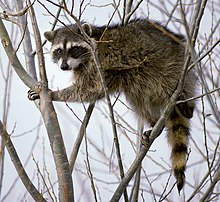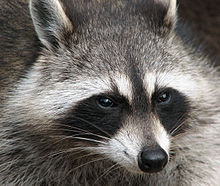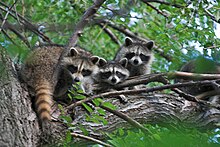From Wikipedia, the free encyclopedia
| Raccoon Temporal range: Pleistocene–Recent [1] | |
|---|---|
 | |
| California raccoon (P. l. psora), Lower Klamath National Wildlife Refuge in California | |
| Scientific classification | |
| Kingdom: | Animalia |
| Phylum: | Chordata |
| Class: | Mammalia |
| Order: | Carnivora |
| Suborder: | Caniformia |
| Family: | Procyonidae |
| Genus: | Procyon |
| Species: | P. lotor |
| Binomial name | |
| Procyon lotor (Linnaeus, 1758) | |
 | |
| Native range in red, introduced range in blue | |
| Synonyms | |
The raccoon r), sometimes spelled racoon,
also known as the common raccoon, North American raccoon, northern raccoon and colloquially as coon, is a medium-sized mammal native to North America. The raccoon is the largest of the procyonid family, having a body length of 40 to 70 cm (16 to 28 in) and a body weight of 3.5 to 9 kg (8 to 20 lb). Its grayish coat mostly consists of dense underfur which insulates it against cold weather. Two of the raccoon's most distinctive features are its extremely dexterous front paws and its facial mask, which are themes in the mythology of several Native American ethnic groups. Raccoons are noted for their intelligence, with studies showing that they are able to remember the solution to tasks for up to three years. The diet of the omnivorous raccoon, which is usually nocturnal, consists of about 40% invertebrates, 33% plant foods, and 27% vertebrates.
The original habitats of the raccoon are deciduous and mixed forests, but due to their adaptability they have extended their range to mountainous areas, coastal marshes, and urban areas, where some homeowners consider them to be pests. As a result of escapes and deliberate introductions in the mid-20th century, raccoons are now also distributed across mainland Europe, Caucasia, and Japan.
Though previously thought to be solitary, there is now evidence that raccoons engage in gender-specific social behavior. Related females often share a common area, while unrelated males live together in groups of up to four animals to maintain their positions against foreign males during the mating season, and other potential invaders. Home range sizes vary anywhere from 3 hectares (7.4 acres) for females in cities to 5,000 hectares (12,000 acres) for males in prairies. After a gestation period of about 65 days, two to five young, known as "kits", are born in spring. The kits are subsequently raised by their mother until dispersal in late fall. Although captive raccoons have been known to live over 20 years, their life expectancy in the wild is only 1.8 to 3.1 years. In many areas, hunting and vehicular injury are the two most common causes of death.
...
 |
| The mask of a raccoon is often interrupted by a brown-black streak that extends from forehead to nose. |
The word "raccoon" was adopted into English from the native Powhatan term, as used in the Virginia Colony. It was recorded on Captain John Smith's list of Powhatan words as aroughcun, and on that of William Strachey as arathkone. It has also been identified as a Proto-Algonquian root *ahrah-koon-em, meaning "[the] one who rubs, scrubs and scratches with its hands".
...
Intelligence
Zoologist Clinton Hart Merriam described raccoons as "clever beasts", and that "in certain directions their cunning surpasses that of the fox." The animal's intelligence gave rise to the epithet "sly coon". Only a few studies have been undertaken to determine the mental abilities of raccoons, most of them based on the animal's sense of touch. In a study by the ethologist H. B. Davis in 1908, raccoons were able to open 11 of 13 complex locks in fewer than 10 tries and had no problems repeating the action when the locks were rearranged or turned upside down. Davis concluded they understood the abstract principles of the locking mechanisms and their learning speed was equivalent to that of rhesus macaques. Studies in 1963, 1973, 1975 and 1992 concentrated on raccoon memory showed they can remember the solutions to tasks for up to three years. In a study by B. Pohl in 1992, raccoons were able to instantly differentiate between identical and different symbols three years after the short initial learning phase. Stanislas Dehaene reports in his book The Number Sense raccoons can distinguish boxes containing two or four grapes from those containing three.
Behavior
Social behavior
Studies in the 1990s by the ethologists Stanley D. Gehrt and Ulf Hohmann suggest that raccoons engage in gender-specific social behaviors and are not typically solitary, as was previously thought. Related females often live in a so-called "fission-fusion society", that is, they share a common area and occasionally meet at feeding or resting grounds. Unrelated males often form loose male social groups to maintain their position against foreign males during the mating season—or against other potential invaders. Such a group does not usually consist of more than four individuals. Since some males show aggressive behavior towards unrelated kits, mothers will isolate themselves from other raccoons until their kits are big enough to defend themselves. With respect to these three different modes of life prevalent among raccoons, Hohmann called their social structure a "three class society". Samuel I. Zeveloff, professor of zoology at Weber State University and author of the book Raccoons: A Natural History, is more cautious in his interpretation and concludes at least the females are solitary most of the time and, according to Erik K. Fritzell's study in North Dakota in 1978, males in areas with low population densities are solitary as well.
...
Diet
Though usually nocturnal, the raccoon is sometimes active in daylight to take advantage of available food sources. Its diet consists of about 40% invertebrates, 33% plant material and 27% vertebrates. Since its diet consists of such a variety of different foods, Zeveloff argues the raccoon "may well be one of the world's most omnivorous animals". While its diet in spring and early summer consists mostly of insects, worms, and other animals already available early in the year, it prefers fruits and nuts, such as acorns and walnuts, which emerge in late summer and autumn, and represent a rich calorie source for building up fat needed for winter. Contrary to popular belief, raccoons only occasionally eat active or large prey, such as birds and mammals. They prefer prey that is easier to catch, specifically fish, amphibians and bird eggs. When food is plentiful, raccoons can develop strong individual preferences for specific foods. In the northern parts of their range, raccoons go into a winter rest, reducing their activity drastically as long as a permanent snow cover makes searching for food impossible.
Dousing
One aspect of raccoon behavior is so well known that it gives the animal part of its scientific name, Procyon lotor; "lotor" is neo-Latin for "washer". In the wild, raccoons often dabble for underwater food near the shore-line. They then often pick up the food item with their front paws to examine it and rub the item, sometimes to remove unwanted parts. This gives the appearance of the raccoon "washing" the food. The tactile sensitivity of raccoons' paws is increased if this rubbing action is performed underwater, since the water softens the hard layer covering the paws. However, the behavior observed in captive raccoons in which they carry their food to water to "wash" or douse it before eating has not been observed in the wild. Naturalist Georges-Louis Leclerc, Comte de Buffon, believed that raccoons do not have adequate saliva production to moisten food thereby necessitating dousing, but this hypothesis is now considered to be incorrect. Captive raccoons douse their food more frequently when a watering hole with a layout similar to a stream is not farther away than 3 m (10 ft).[150] The widely accepted theory is that dousing in captive raccoons is a fixed action pattern from the dabbling behavior performed when foraging at shores for aquatic foods. This is supported by the observation that aquatic foods are doused more frequently. Cleaning dirty food does not seem to be a reason for "washing".[150] Experts have cast doubt on the veracity of observations of wild raccoons dousing food.
...






No comments:
Post a Comment